|
 Notholepiota areolata Notholepiota areolata
SynonymsSecotium areolatum
BiostatusPresent in region - Indigenous. Endemic
Images (click to enlarge)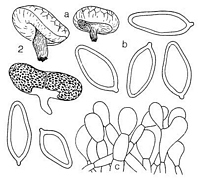
Caption: Notholepiota areolata (Cunningham) Hk.: a. carpophores (nat size) b spores (2000 x). c. cuticle (500
x). | 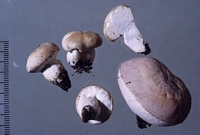
Owner: Herb. PDD | 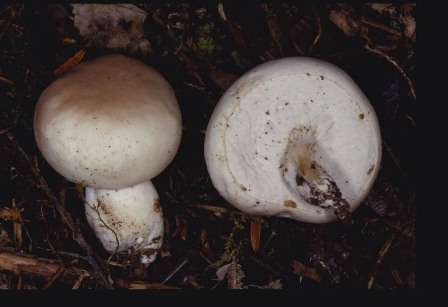
Caption: Notholepiota areolata
Owner: R.E. Beever | 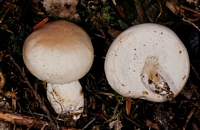
Caption: REB 1488
Owner: Ross Beever | 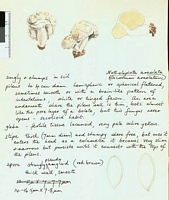
Caption: watercolour
Owner: G.M. Taylor | 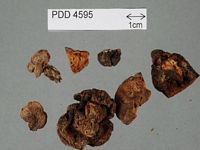
Caption: Dried type specimen
Owner: Herb PDD |
Article: Horak, E. (1971). Contributions to the knowledge of the Agaricales s.l. (Fungi) of New Zealand. New Zealand Journal of Botany 9(3): 463-493 (http://www.rsnz.org/publish/abstracts.php).
Description: Only very few remarks can be added to the
detailed original description of Secotium areolatum. The spores measure about
13-18 x 7-8.5 µm. are strongly dextrinoid, smooth, thick-walled (ca. I u. diam.)
and lack a germ pore. Basidia and cystidia were not observed
Notes: This new secotioid genus is characterised
by the form of the fruiting bodies, the thick-walled, dextrinoid spores (without
a germ pore), and the hymeniform cuticle. These characters put the genus close
to Lepiota s.l., but it has nothing in common with Brauniella
Rick ex Singer 1955 another related secotiaceous genus known from South America.
Article: Cunningham, G.H. (1942). Two additional New Zealand Gasteromycetes. New Zealand Journal of Science and Technology. B. General Section 23: 172-173.
Description: Peridium depressed globose or sub-turbinate, to 3 cm. tall, 4 cm: diameter, apex bluntly
rounded, base abruptly truncated, slightly excavated ; exterior at first white, in dried plants
ochraceous, smooth, slightly viscid, irregularly areolate, base finely pubescent and somewhat
papillate ; composed of two layers, the outer about 100 µ thick, composed of septate hyphae
partly gelatinized and arranged in a vertical palisade absent from the truncate base, the inner
of hyaline pseudoparenchyma to 800 µ thick, firm and compact. Stem at first white,
becoming greyish or ochraceous, to 2 cm. long, 1 cm. thick, tapering, smooth, dull, hollow,
attenuated abruptly at the glebal margin to a narrowly cylindrical columella 2-3 mm. thick
and white. Gleba closely oppressed to the columella, ferruginous, cells lenticular, to 1 mm.
long; tramal plates 30-60 µ thick, pseudoparenchymatous ; basidia 4-spored. Spores ovate-elliptical or
ovate-fusiform, 10-16 x 6-8 µ (occasionally attaining a length of 20 µ), irregular
in size and shape, bluntly acuminate or rounded, base bluntly pointed, apiculate, epispore
pallid ferruginous, smooth, 1 µ thick.
Notes: The species is separated from S. viresens and S. erythrocephalum principally by the peculiar
structure, areolated appearance, and different colour of the peridium. It is composed of two
layers, the outer being so constructed of hyphae arranged in a palisade that it ruptures readily,
exposing the tough pseudoparenchymatous inner layer and giving to plants their areolated
appearance. Spores resemble those of S. erythrocephalum in shape.
|